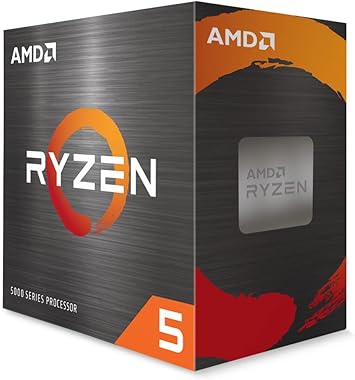AMD Ryzen 5 5500

The AMD Ryzen 5 5500 features 6 cores and 12 threads, making it an excellent choice for multi-tasking and gaming. With a base clock speed of 3.6 GHz and a boost clock of 4.2 GHz, it delivers strong performance while maintaining a power consumption of 89 watts.
Popularity: High
Performance:
Specifications:
Model: AMD Ryzen 5 5500
Series:
Architecture:
Socket: AM4
Cores: 6.0
Threads: 12.0
Base Clock:
Max. Boost Clock:
L2 Cache:
L3 Cache:
TDP:
Power Consumption: 89.0 W
Max Memory:
Max Memory Speed:
Max Temp:
PCI Express Version:
PCIe Lanes:
Overclocking:
Integrated GPU: no
Cooler Boxed: yes
Instruction Set:
Launch Date:
Manufacturer Page: Link
Review
The AMD Ryzen 5 5500 processor offers a compelling package for those seeking a budget-friendly upgrade path. Priced at $83.47, this processor is an enticing option for those looking to enhance their system without breaking the bank. Featuring 6 cores and 12 threads, the Ryzen 5 5500 is designed to deliver balanced performance across a variety of applications, with a base clock speed of 3.6 GHz and a boost clock that can reach 4.2 GHz. But how does it fare against its competitors and other options within AMD's own lineup? Let's dive in deeper to explore its performance and positioning.
Design and Architecture
The Ryzen 5 5500 is part of AMD's celebrated Zen 3 architecture, specifically dialed-down from its higher counterparts. However, it is crucial to note it was originally designed as an APU, a processor with integrated graphics, but in this case, the integrated graphics are completely disabled. This architectural choice results in a significant reduction in the L3 cache to 16MB, impacting certain performance metrics compared to other processors in the series, such as the Ryzen 5 5600, which sports 32MB. The decision to limit the cache is closely tied to cost strategy, allowing AMD to offer the Ryzen 5 5500 at its current price point [PCMag].
Performance and Benchmarks
- Gaming Performance: Utilizing an external GPU like the Nvidia GeForce RTX 3080 Ti, the Ryzen 5 5500 delivered modest gaming results. At 1080p, it trailed behind the higher-priced Ryzen 5 5600 and Intel's Core i5-11600K, both of which offered better efficiency and frame rates. The Ryzen 5 5600, for instance, achieved 22% better performance for an 18% price increase in certain gaming scenarios [PcTekReviews].
- Productivity and Multi-tasking: The Ryzen 5 5500 provides competitive results in productivity benchmarks. While it fell short of the Ryzen 5 5600’s performance due to the reduced L3 cache, it excelled in power efficiency with an average consumption of 36 Watts, which is impressive compared to Intel's Core i5-12400 [Phoronix].
Pros and Cons
While the AMD Ryzen 5 5500 presents several advantages, such as its price, low power consumption, and the ability for basic overclocking, there are notable drawbacks. The absence of integrated graphics limits its appeal for non-gaming builds, especially in the current market where GPU prices remain high. Furthermore, as benchmarks indicate, the limited cache size noticeably impacts performance in both gaming and heavy multitasking environments [PCMag].
Verdict
The AMD Ryzen 5 5500 is not without its merits; it offers a well-rounded, power-efficient processor for those on a strict budget. Yet, the competitive landscape suggests better alternatives might be available for a slight increase in cost, primarily through AMD's own Ryzen 5 5600 or similarly priced Intel CPUs. For users who can stretch their budget a little further, these competitors present more robust options with better overall performance metrics. Nevertheless, for those locked into an AM4 motherboard and seeking a reasonably priced, multipurpose upgrade, the Ryzen 5 5500 remains a viable consideration.